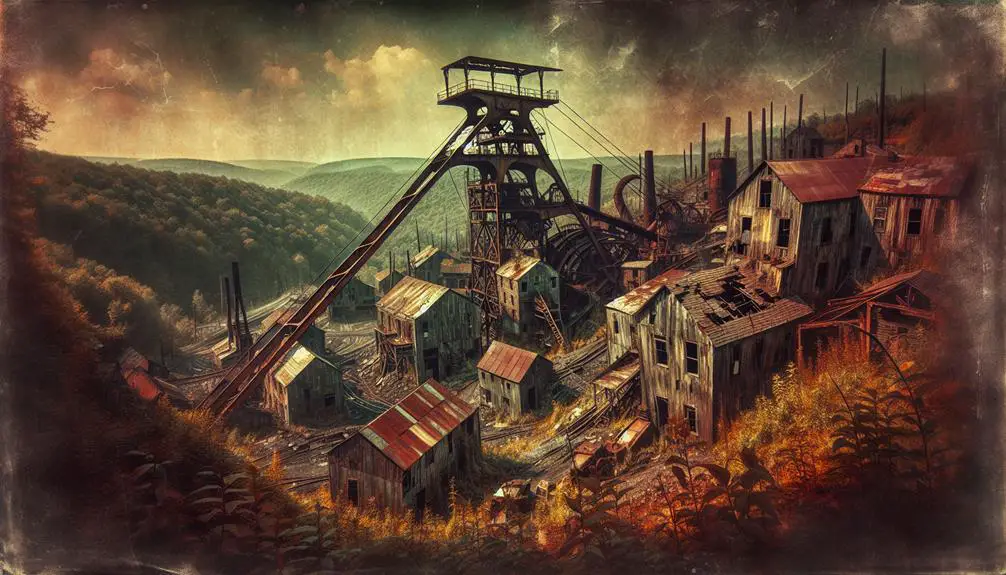Exploring Appalachian ghost town historical preservation poses challenges. Economic constraints hinder restoration efforts due to limited funding. Lack of awareness impacts cultural significance. Environmental degradation jeopardizes long-term preservation through pollution and habitat destruction. Infrastructure decay risks structural integrity. Limited funding remains a significant obstacle, essential for repairs and artifact preservation. Overcoming challenges requires creative solutions like partnerships, education, and fundraising. Each challenge uniquely tests the perseverance of preserving these time-forgotten settlements.
Key Points
- Limited funding impedes preservation efforts and restoration projects.
- Lack of awareness affects cultural significance and historical value.
- Environmental degradation threatens long-term preservation.
- Infrastructure decay endangers structural integrity.
- Community engagement is crucial for addressing preservation challenges.
Economic Constraints
Economic constraints greatly impact the preservation efforts of Appalachian ghost town historical sites, presenting formidable challenges to maintaining their cultural heritage. In the context of community engagement, limited funding often hinders the ability to involve local residents in restoration projects. When economic resources are scarce, it becomes challenging to organize community events, workshops, or volunteer programs that could enhance the connection between the people living near these historical sites and their own history.
Moreover, tourism development, a potential revenue source for preservation efforts, is also hindered by economic constraints. Lack of funds for marketing, infrastructure improvements, and visitor amenities can limit the ability to attract tourists to these ghost towns. Without a steady flow of visitors, generating income to support ongoing preservation becomes increasingly difficult, perpetuating a cycle of financial struggle.
To overcome these economic challenges, creative solutions such as seeking partnerships with local businesses, applying for grants, or establishing crowdfunding campaigns could help alleviate some of the financial burdens associated with preserving Appalachian ghost town historical sites. By finding innovative ways to fund community engagement initiatives and boost tourism development, these historical sites can continue to thrive and share their unique stories with future generations.
Lack of Awareness
Amidst the preservation efforts of Appalachian ghost town historical sites, a significant challenge arises from the pervasive lack of awareness regarding the cultural significance and historical value these locations hold. The lack of awareness stems from a variety of factors, including limited community engagement and insufficient educational initiatives. To address this issue, it's important to implement strategies that promote greater awareness and appreciation for these ghost town sites.
Community engagement plays an essential role in raising awareness about the importance of preserving these historical locations. By involving local communities in preservation efforts, individuals can develop a sense of ownership and pride in their heritage. Educational initiatives are also crucial in enhancing awareness. Schools, museums, and historical societies can play a key role in educating the public about the significance of these ghost towns through guided tours, workshops, and informational materials.
Environmental Degradation
Given the fragile nature of many Appalachian ghost town historical sites, the issue of environmental degradation poses a significant threat to their long-term preservation and cultural significance. Pollution impact from nearby industrial activities or improper waste disposal can lead to soil and water contamination, affecting the overall health of the ecosystem within these sites. The presence of pollutants not only damages the physical structures present but also harms the surrounding flora and fauna, disrupting the delicate balance that once existed in these abandoned towns.
Moreover, habitat destruction due to deforestation or mining activities in the vicinity of these ghost towns further exacerbates the environmental degradation. The loss of natural habitats can drive away wildlife that once inhabited these areas, diminishing the biodiversity that adds to the historical richness of these sites. As a result, the unique historical and cultural value of these ghost towns is at risk of being eroded by the adverse effects of pollution and habitat destruction, highlighting the urgent need for conservation efforts to mitigate these threats.
Infrastructure Decay
Infrastructure decay within Appalachian ghost town historical sites poses a critical threat to their structural integrity and overall historical significance. The dilapidation of key structures such as old homes, churches, and businesses not only detracts from the visual appeal of these sites but also endangers their long-term survival. Preservation efforts are important in combating this decay. By implementing regular maintenance, restoration projects, and structural assessments, these historical sites can be safeguarded for future generations to appreciate.
Community engagement plays an essential role in addressing infrastructure decay within these ghost towns. Involving local residents, historians, and volunteers in preservation initiatives fosters a sense of ownership and pride in the historical significance of these sites. Through workshops, clean-up events, and fundraising drives, communities can rally together to protect and revitalize their shared heritage.
To combat infrastructure decay effectively, a collaborative approach that combines preservation efforts with active community engagement is necessary. By working together to address this challenge, Appalachian ghost town historical sites can be preserved for years to come, maintaining their cultural and historical value.
Limited Funding
Limited funding presents a significant obstacle to the preservation and maintenance of Appalachian ghost town historical sites. Without adequate financial resources, these sites struggle to address critical needs such as structural repairs, historical artifact preservation, and staff salaries. Community engagement plays an important role in overcoming this challenge. By involving local residents, historical enthusiasts, and businesses in fundraising efforts, ghost town preservation projects can secure the necessary funds to sustain their operations.
Effective community engagement strategies can include organizing fundraising events like auctions, benefit concerts, or historical tours. Additionally, establishing partnerships with local businesses for sponsorships or donations can provide a much-needed financial boost. By fostering a sense of ownership and pride in these historical sites within the community, fundraising efforts can be more successful and sustainable in the long run.
However, despite the importance of community engagement and fundraising, the limited availability of funding remains a persistent issue for Appalachian ghost town historical preservation. Innovative approaches and continued advocacy are essential to guarantee the long-term viability of these valuable historical sites.
Frequently Asked Questions
What Are Some Specific Examples of Economic Constraints That Have Hindered Historical Preservation Efforts in Appalachian Ghost Towns?
When considering economic constraints impacting preservation efforts in Appalachian ghost towns, factors like limited funding sources, lack of tourism revenue, and high restoration costs can hinder the ability to maintain historical sites effectively.
How Does Lack of Awareness About the Importance of Preserving Ghost Town History Impact the Overall Preservation Efforts in the Region?
When you lack awareness of the importance of preserving ghost town history, the overall preservation efforts suffer. Without understanding the significance, support dwindles, hindering progress in safeguarding these valuable remnants of the past.
What Are Some of the Environmental Degradation Issues That Have Affected Appalachian Ghost Towns and How Are They Being Addressed?
In Appalachian ghost towns, environmental degradation issues like pollution and habitat destruction threaten historical sites. Conservation efforts focus on cleanup projects, promoting community engagement in restoration, and raising awareness about the importance of preserving these unique cultural and environmental treasures.
In What Ways Does Infrastructure Decay Pose Challenges to the Preservation of Appalachian Ghost Towns and What Are Some Potential Solutions?
Decay of infrastructure in ghost towns presents preservation challenges. Lack of funds and expertise hinder conservation efforts. Encouraging community engagement can raise awareness and support. Implementing adaptive reuse strategies, like converting old buildings, can revitalize these historic sites.
How Have Limited Funding Sources Impacted the Ability to Effectively Preserve and Maintain the Historical Integrity of Appalachian Ghost Towns?
Limited funding sources impact the ability to effectively maintain historical integrity in Appalachian ghost towns. Preservation efforts suffer, hindering essential upkeep and restoration projects. Overcoming funding limitations is vital to safeguarding these valuable pieces of history.



